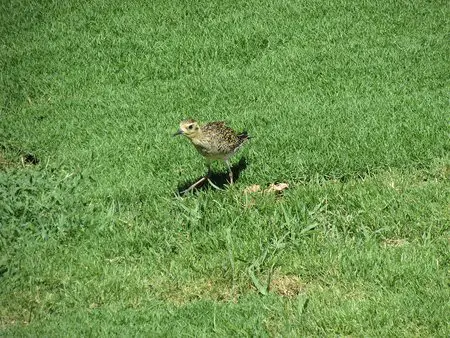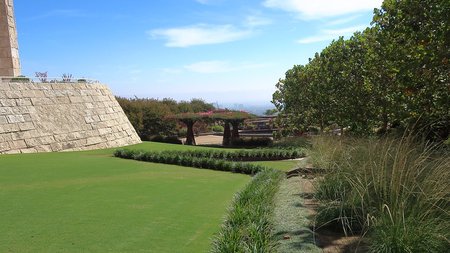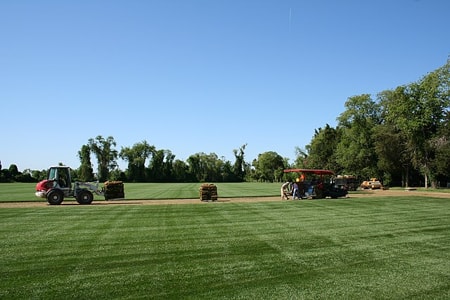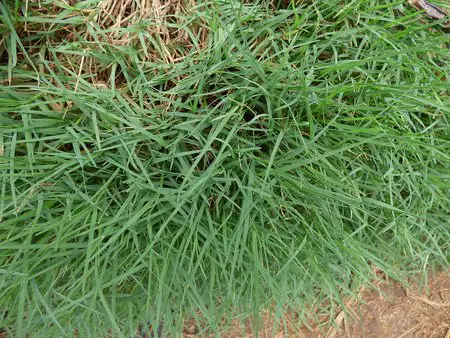Bermuda Grass vs Fescue
Confused which might be the right grass for your lawn... Bermuda or Fescue? Well, hopefully once you go through this article, you should be clear about which type is right for your lawn. The selection of the right type depends on several factors, and I shall discuss each factor separately in the sections below and compare the two types, and their pros and cons.
Common Bermuda Grass
Photo: Forest and Kim Starr, flickr, cc by 2.0
The most popular types of Bermuda grass that are used in lawns are Improved Common Bermuda Seeds and Hybrid Bermuda Sods. Fescue grass comes in various seed varieties as well as in form of sods. Out of many Fescue varieties, the Fine Fescue such as Creeping Red Fescue, Hard Fescue, Chewings Fescue, and Sheep Fescue are commonly used in lawns although Turf Type Tall Fescue (TTT Fescue) has also become quite popular as lawn grass.
Temperature
Bermuda grass is a warm-season grass, and a soil temperature of 65-75 °F is ideal for this grass to thrive. Bermuda is mostly used in the southern and western parts of the United States that experience warm climate. On the other hand, Fescue is a cool-season grass and quite suitable for the northern parts of the US. The ideal soil temperature for Fescue seeds to germinate thoroughly and root systems to develop is in the range of 55 - 65°F.
Hybrid Bermuda Grass (Tifway)
Photo: cultivar413, flickr, cc by 2.0
USDA (United States Department of Agriculture) has defined the Hardiness Zones of various areas within the US. A Hardiness Zone is defined based on the average annual minimum temperatures of an area in which plants may need to survive. Gardeners can therefore find out the hardiness zones for their locations and determine which plants can survive and thrive in their own respective areas. There are 13 such Hardiness Zones (0 - 12) defined by USDA. For example, a Hardiness Zone of 7 would mean that a plant will need to survive in a minimum temperature range of 0°F to 10°F (i.e. -17.8°C to -12.2°C).
The Hardiness Zones for Fescue and Bermuda grass are different. The USDA Hardiness Zone for Fescue is 2 to 7 while that for Bermuda is 7 to 10. So, Fescue can withstand temperatures much lower than Bermuda grass. Depending on your locality (or zone), you can check the
USDA zone map to know the hardiness zone and see which of the two grass types would be more suitable for your area. If your USDA Hardiness Zone is around 7, both Fescue and Bermuda grass would be suitable as far as the temperature is concerned.
Sunlight
Bermuda grass requires a lot of sunlight and can not grow well in shaded areas. So, if your lawn is exposed to sunlight and doesn't have canopy of trees, then Bermuda would be a good choice, otherwise not.
One of the strongest selling points of Fescue is its shade tolerance. The Fine Fescue such as the Creeping Red or Chewings varieties have the highest shade tolerance among all cool-season grasses followed by the Turf Type Tall Fescue. These Fescue grasses can thrive in lawns that get minimum of 4-5 hours of partial sunlight a day.
Tall Fescue turfgrass sod in Annapolis, Maryland
Drought Tolerance
Bermuda grass is known for its exceptional heat and drought tolerance. Although most of the root system of Bermuda remain within 6 inches of the soil surface, they can go all the way up to 6 feet. It is because of such extensive and deep root systems that Bermuda is much more resilient to drought compared to any other warm-season grasses. Bermuda grass would go dormant during the winter time (i.e. the dry season) and turn brownish. It starts turning green again during spring.
Among the cool-season grasses, Fescue is also one of the most drought resilient grasses. Their root system can reach to the depths of 2-3 feet below the soil surface and can extract nutrients during the dry spells. Their roots go deeper than most other cool-season grasses in the US. It is because of this reason, a Fescue lawn remains green for much of the year.
If you compare the two, Bermuda grass is more tolerant to drought than Fescue and requires lesser watering during the dry season, and that may mean some saving on your water bills.
Disease & Insect Tolerance
Bermuda grass is quite susceptible to mole crickets, nematodes and fungal disease like the Dollar Spots. During spring you can sometimes see a circular straw-colored patch 6-12 inch in diameter which could grow over time and become several feet wide. These are dollar spots which mainly happen due to inadequate watering and irrigation and when soil temperature goes below 65°F. Read
Bermuda Grass Lawn Maintenance to know more about the disease and insects that affect Bermuda grass and the remedies.
Fescue on the other hand can be susceptible to fungal diseases, particularly if the nitrogen content in the soil is too much. However, Fescue is one of the rare turf grasses that can symbiotically host the fungus Endophytes which do not reach any harm to the grass but provide resistance towards insects and at the same time helps the grass to withstand drought and heat. In fact, Fescue grass, particularly Fine Fescue, hardly requires pesticides compared to other grasses.
Fescue also discharges an amino acid called meta-tyrosine through its root system. When this meta-tyrosine is consumed by the weeds such as crabgrass, they tend to die off or their growth and spread gets retarded. This gives Fescue the upper-hand to thrive while warding off the weeds naturally.
Foot Traffic Tolerance
Both Bermuda and Fescue are tolerant to foot traffic and known to withstand wear and tear. So, you don't need to worry about your kids or pets playing around in the lawn. However, Bermuda grass is comparatively a little more tolerant to heavy foot traffic and can quickly repair itself when damaged.
Growth
Bermuda grass grows and spreads quite fast through rhizomes (roots below the ground) as well as stolons (roots above the ground) and will usually cover up the lawn in one year itself, if the soil conditions are properly taken care of. However, unless controlled properly, this aggressive nature of Bermuda can make it an invasive plant for your other plantation areas (such as the flowering plantations) where it can become harmful weeds.
Bermuda grass on an average grows to a height of 2 inches. Seeds of Fescue (including that of Fine Fescue) germinate rapidly within 14-21 days and grow quite fast in bunches, however it can take time for it to fully establish. With the exception of Chewings and Red Creeping varieties that spread through rhizomes, most types of Fescue clump and form tufts. Unless controlled, Fescue can grow to a height of several feet.
Look and Texture
Common Bermuda Grass has a medium to coarse texture and is green in color (sometimes the shade of green may vary though). The leaf blades of Bermuda grass come out at and angle of around 45 degree and feel soft. The blades can grow as wide as 1/6th of an inch and do not have hairs or have very small hairs on both sides of the blade (but not on top of the blade). You need to mow and maintain common Bermuda grass at a height of 3/4 to 1 inch. However the recommended height of Hybrid Bermuda is 1.5 inch.
Bermuda Grass (Close Up View)
Photo: Forest and Kim Starr, flickr, cc by 2.0
Hybrid Bermuda Grass can have fine textures, different shades of green and their blades can be much thinner (up to 1/16th of an inch). Hybrids, like common Bermuda grass, also have good tolerance to traffic and can form a denser and thicker lawn compared to the common variety. Some examples include 'Tifgreen' that are fine-textured, bluish green, and 'Tifway II' that are medium-textured, dark green. Hybrid Bermuda can provide a turf-like finish and a luscious lawn that is hard for any other type of grass to match.
Bermuda grass turns brownish (and goes into dormancy) when the dry season starts (after fall) and start turning green only in spring. Some gardeners choose to overseed Bermuda during the fall and winters in order to minimize the brown period. This is however, not required for Fescue.
Fine Fescue has fine leaf texture with high leaf density. The leaves are medium to bluish green. It remains green for most part of the year. The Tall Fescue is however medium to dark green in color, and have relatively coarse texture and wider leaf blades. Fine Fescue should be maintained at a height of 1 to 3 inches, while Tall Fescue between 1.5 to 4 inches.
Maintenance
Bermuda grass requires full sun while Fescue can also grow in moderate shades. Bermuda grass requires a soil pH between 5.5 to 7.0 while Fescue requires a pH level of 5.0 to 6.5 for ideal growth and spread. So for Fescue, it's quite unlikely that you will need to add lime to the soil.
You will need to irrigate and water Bermuda grass regularly and keep 1 inch of water level during spring and summer. On the other hand, Fine Fescue is a low maintenance grass and has low irrigation needs, although you need to maintain consistent level of moisture in the soil while establishing Fescue.
Bermuda grass will require half to one pound of nitrogen for every 1,000 square feet of lawn in an interval of 4-6 weeks during spring and summer. Note that Hybrid Bermuda Grass (which is used in making sods) requires higher level of attention and care compared to Common Bermuda Grass. Go through
Bermuda Grass Lawn Care for details on how to maintain a Bermuda lawn.
Fescue on the other hand has low nitrogen requirements and a good quality slow-release organic fertilizer should be enough to maintain a healthy level of nutrients in the soil. Fescue can actually thrive in poor soil conditions (such as clay, rocky or sandy soil). Creeping Red Fescue particularly has great salt tolerance and is an ideal choice for roadside grass.
Fescue will however go into dormancy if there is continuous excessive heat without any supplemental irrigation. In excessive heat and humidity during summers, Fescue can even develop brown patches. The grass will however recover and become green when the rainy season starts and there is adequate moisture in the soil.
Bermuda grass grows fast and requires frequent mowing and watering. Between June to November, Bermuda will require mowing every 5-7 days (less frequently during the winters). Check out
Mowing & Watering Bermuda Lawn for details. Bermuda will also spread more vigorously into adjacent areas, so there will be diligent effort required to keep it in control.
Comparatively, Fescue requires infrequent mowing... about 1 to 3 times a month between June to August in order to maintain it at 3 inches. In fact, some types of Fescue such as the Blue Fescue is great for unmowed natural settings and Tall Fescue requires mowing only once a month. Most Fescue lawns can be mowed when the grass is 4 inch tall. Mowing enables the clumps to spread and helps establish a lush green lawn. Tall Fescue seldom develops thatch and therefore hardly requires dethatching.
So, in general, Bermuda will require a lot more time and passion if you want to establish and maintain a luscious lawn. While Fescue is easier to grow and maintain.
Cost
Both Bermuda grass and Fescue are available in forms of seeds as well as sods. Bermuda grass is pricier than Fescue. Bermuda sods are produced using Hybrid Bermuda Grass which is a cross between the Common Bermuda Grass and another species of grass.
The average cost of Bermuda Hybrid sod (like Tifway 419 or TexTurf 10) would be in the range of $0.57 – $0.84 per square foot. While the average cost of Fine Fescue is in the range of $0.39 – $0.46 per square foot. You will of course need to add the sod installation cost to this (if you have already purchased the sods, you can hire a professional to install the sods at a rate of $40 to $80 an hour).
The seed option is cheaper. Average cost of one pound of Improved Common Bermuda seed is around $5.0 to $9.0 and that should be enough for a new lawn of 450 sq. ft. The average cost of Fescue is $2.7to $3.6 per square feet and one pound can be used to establish a lawn of about 170 square feet.
If you want to use sods instead of seeds, then avoid buying and planting that in winter, because you won't know its real quality or if it is has a lot of unwanted weeds until it greens up fully during spring.
If you like to know more about the implications between seeded and sodded Bermuda lawns, or want to know the steps of planting Bermuda sods, then go through
How to go about Bermuda Sods.
Buying Bermuda / Fescue Grass
If you are located in the USA, you can go through the following links depending on whether you want to buy Bermuda Grass or Fescue Grass:
|
 By Raj Bhattacharya By Raj Bhattacharya
Raj, a seasoned travel writer and Bermuda destination expert, has extensive global travel experience. This website reflects his profound insights, garnered over nearly two decades of dedicated findings and research on the island. Raj has assisted countless Bermuda-bound visitors by providing direct, personalized responses to their queries and imparting his wealth of knowledge through this platform. This site serves as an indispensable guide for those seeking informed and reliable insights into Bermuda's treasures.
|
Related Articles
3) Check out
Bermuda Grass for a complete guide on Bermuda Grass and Lawn Care.




 By Raj Bhattacharya
By Raj Bhattacharya